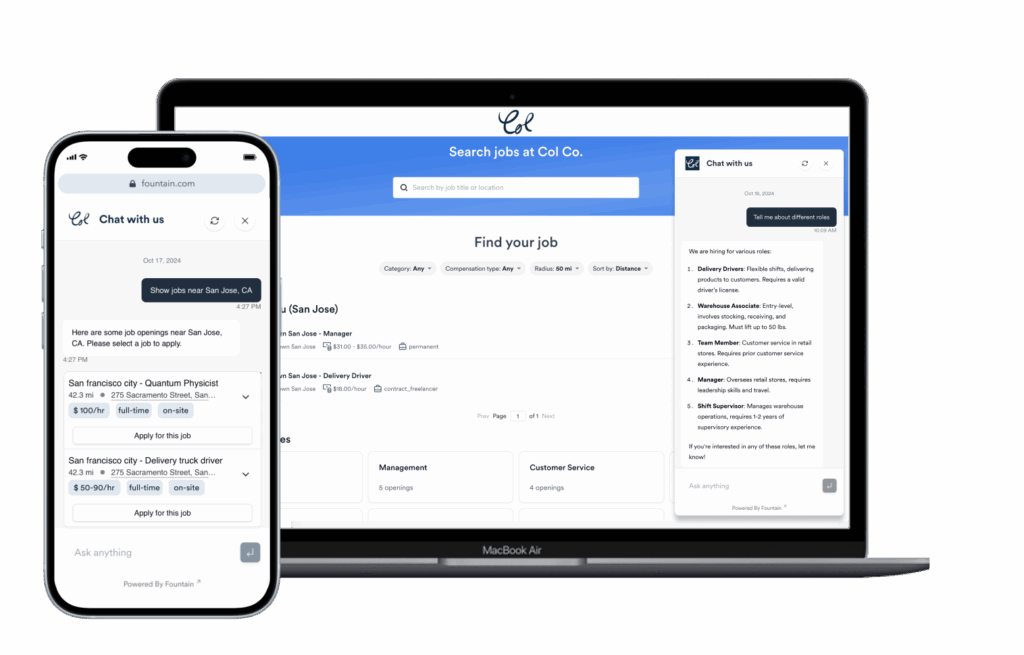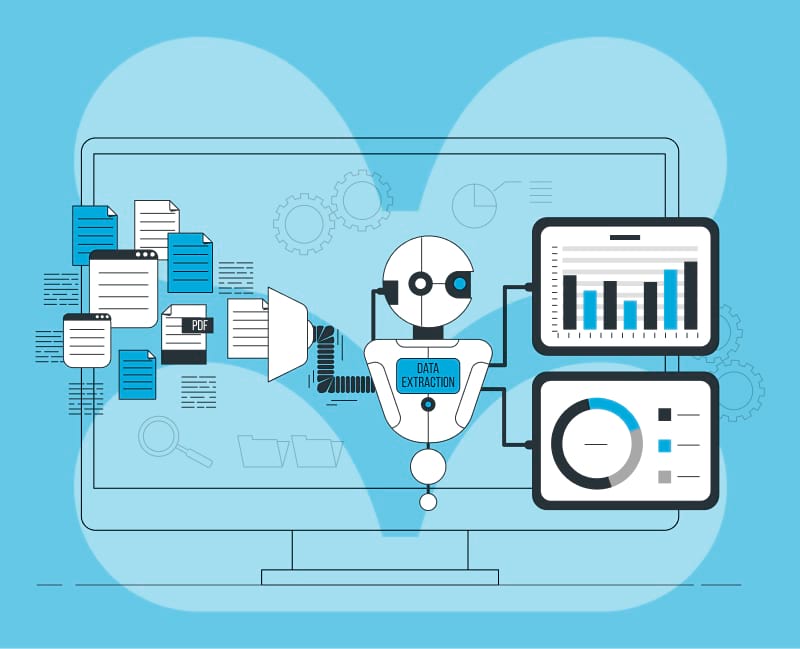As the global talent landscape gets increasingly competitive, recruiters who hire high volumes of workers face mounting challenges. These include hiring fast enough to get top talent on their teams, optimizing processes to get candidates through as quickly and seamlessly as possible, and ensuring new hires have everything they need to succeed at their jobs. Thankfully, for recruiters, AI recruiting software has evolved to be able to handle some of these challenges, not only simplifying the application process for candidates but also freeing up valuable time and resources on the recruiter side.
In this post, we’ll:
- explain how you can use AI recruiting software to build a winning hiring strategy,
- reveal how to improve every aspect of the hiring process, from sourcing to screening to onboarding,
- review the risks and rewards of recruiting with AI, and
- share advice to help you evaluate different AI recruitment software.
AI strategies for each stage of recruitment
The high volume recruitment process can look very different depending on how you want to hire and who you want to hire. However, most hiring funnels consist of the following standard steps. Keep reading to see how AI can enhance these steps and make recruiting easier for everyone involved.
Recruitment marketing
Recruitment marketing involves creating pipelines of ready-to-work talent. During this stage, recruiters start to build relationships through communication such as SMS/text messages, conversational AI, and/or emails. This stage can be challenging for recruiting teams that are stretched thin and don’t have the time to commit to relationship-building with potential candidates.
AI can help improve this stage with chatbots designed to answer frequently asked questions about the role, the company, or the interview process. This can help potential applicants decide whether they want to apply without directly involving recruiters, which, in turn, saves time.
Sourcing
Sourcing applicants is one of the biggest challenges for recruiters of hourly workers. Finding the right channels, attracting the right candidates, and using the best system to manage sourcing can be roadblocks to efficiency, but AI makes this all-important step a lot easier.
Sourcing can get a boost from AI through automated job postings on digital channels. Applicants can submit their application in just minutes thanks to AI-powered chatbots that handle basic information, accept document uploads, and, as mentioned in the Recruitment Marketing section, answer FAQs to keep candidates informed and engaged.
By automating this aspect of recruitment and hiring, recruiters can save time, increase efficiency, and make more informed decisions about who to invite for interviews and ultimately hire.
Screening
Screening requires recruiters to analyze candidate qualifications to make sure they’re suitable and qualified for the role. In the past, recruiters had to manually review each application, but with advancements in technology, recruiters can rely on automation to extract candidate information from applications, issue assessments, and process certification uploads.
Conversational AI can be used at the top of the hiring funnel to screen resumes or applications, ask candidates pre-screening questions, and provide real-time feedback. With an automated screening and selection process, recruiters can more easily identify the best candidates and make better hiring decisions.

Assessment
Assessments are vital for companies that want to get an idea of a candidate’s potential for their company, not just in terms of skills but also regarding culture fit.
Using AI-powered assessments, companies can objectively evaluate candidates’ skills and abilities, ensuring they are hiring candidates who have the necessary qualifications for the position. These assessments can be tailored to the specific requirements of the job and can be used to evaluate a wide range of competencies, from technical skills to soft skills such as communication and teamwork.
Learn how Fetch used Fountain’s Yardstik integration to qualify candidates in only one day
Interviewing
The interview stage is often the most time-consuming for both recruiters and candidates. Scheduling, following up, and back-and-forth messaging can drag out the process for eons. But AI takes care of the logistics, allowing the human interaction to be one of quality and substance.
Conversational AI can also help streamline the interview scheduling process. By using AI-powered tools, recruiters can automate the task of scheduling interviews and reduce the amount of time spent coordinating with candidates. AI chat tools can quickly and easily arrange interviews, provide directions to the interview location, and even send reminders to candidates, all without the need for human intervention.
Onboarding
When a recruiter extends an offer and the candidate accepts, the hiring process isn’t over. Engaging new hires is just as important as keeping them moving through the hiring funnel. This continued engagement affects their sentiments about the organization and can impact longevity.
Once a candidate is hired, AI can ensure new hires have access to everything they need to get up to speed quickly, including providing information on company policies and procedures, sharing links to training materials, answering common questions, and even conducting virtual onboarding sessions.
Essential AI tools and support functions
When analyzing various AI recruiting software options, the following features and functions should come standard with the solution you choose.
- Sourcing. Use AI recruiting software to search multiple online sources like social media, job boards, and professional networks to find potential applicants.
- Screening. AI can analyze and filter through large numbers of applications to identify qualified candidates based on predefined criteria.
- Background checks. Automate candidate information verification, such as employment history, educational qualifications, and professional certifications, to ensure accuracy and streamline the hiring process.
- Chatbots. Chatbots engage with candidates, answer questions, provide information about the company and the hiring process, and assist with scheduling interviews.
- Scheduling. By syncing with recruiters’ calendars, AI can provide appointment availability to candidates and candidates can schedule slots via chatbot.
- Data and insights. A robust AI hiring tool should allow hiring teams complete visibility into the hiring process so they can keep track of efficiencies and make changes as needed.
Read our guide: How to use AI for optimal candidate engagement
How to get the most out of your AI recruiting software
The use of AI recruiting software can streamline workflows, reduce costs, and lead to faster and more accurate decision-making, making it a valuable tool for enterprise businesses looking to hire at scale and stay competitive in today’s tight hiring market. See below to learn how to get the most out of your AI recruiting software, from easy implementation to results-driven execution.
Define your objectives and problems to solve
Before adopting AI, you’ll first want to identify how it will solve specific recruitment funnel pain points that are impeding your ability to meet your hiring goals. For example, you may be searching for a way to stay more connected to candidates as they complete the early stages of the process.
By clearly defining your goals and objectives, you’ll be able to implement the new technology with a keen understanding of its purpose and the results you expect.

Train your team
Provide adequate training and support to your recruiters to ensure they understand AI’s functionality, can address common candidate inquiries, and can leverage analytics to make informed hiring decisions.
Leverage data and analytics for best-fit decisions
Before implementing AI recruiting software, ensure you’re set up to conduct thorough testing and evaluation of the tool’s functionality, accuracy, and user experience. This will help ensure you’re meeting the desired objectives you identified.
Create a continuous feedback loop
If a large part of your AI hiring strategy is to improve candidate experience, why not let them share their insights? Implement mechanisms to collect feedback on your AI hiring tool, and monitor candidates’ interactions with the chatbot to identify areas for improvement.
The risks (and rewards) of AI recruiting software
Using AI is an exciting prospect with heaps of potential, but there also are risks that need to be considered. It’s also important to note that AI-powered solutions support human decision-making—they don’t replace it.
Risks
- Initial investment. Adding AI to your hiring funnel may require an upfront investment, but the cost savings that come with faster, more streamlined processes that deliver more qualified candidates can quickly offset these costs.
- Workflow compatibility. As with any new technology, users need to make sure it’s compatible with their existing systems and that adding it won’t cause too much disruption.
- Ethical and regulatory compliance. Ethics are one of the more murky aspects of using AI to hire workers. Companies must ensure they use AI recruiting software responsibly to ensure fairness, transparency, and compliance with legal and regulatory frameworks.
Rewards
- Cost savings. While there may be upfront costs to purchase and implement AI tools, these tools can help save money over time by increasing recruiter efficiency, reducing time spent on manual tasks, and enabling self-service and automation.
- Accelerated hiring funnel. Implementing AI enables companies to provide immediate responses to applicants and ensure HR teams are available 24/7. This can help accelerate the recruitment process and ensure companies can attract and hire top talent.
- Improved candidate experience. AI’s automated messaging capabilities can help create a more consistent HR experience for candidates and allow companies to incorporate their brand and culture into the recruitment process.

Tips for evaluating AI recruitment software
New AI recruiting solutions emerge every day, so your search may require a considerable time investment. Remember that your ideal tool will offer a holistic solution for optimizing the hiring funnel from the top down.
To help you with your search for the best AI recruiting software for you and your hiring team, here are a few tips.
- Define objectives. Identify the goals and objectives you want to meet by implementing a new AI tool, including the specific hiring pain points it should address like reducing time-to-hire, improving the candidate experience, or enhancing screening efficiency.
- Assess data security. Make sure the AI software you choose complies with all data and security privacy regulations, locally, nationally, and internally. Verify that it follows best practices for data encryption, storage, and access controls to protect sensitive information.
- Determine integration requirements. Evaluate whether the AI tool would be compatible with existing HR systems or whether it requires additional customization.
- Test and evaluate for continuous improvement. Conduct thorough testing and evaluation of the AI tool before deployment. Test its functionality, accuracy, and user experience with different scenarios to ensure it meets the desired objectives and aligns with candidate expectations.
- Ensure compliance and bias mitigation. The tool should adhere to legal and ethical guidelines, including compliance with anti-discrimination laws.
- Consider training and support for HR teams. Provide adequate training and support to your HR team to make sure they understand AI’s functionalities, can address common candidate inquiries, and can leverage analytics to make informed hiring decisions.
Find, engage, and hire the right candidates, faster, with AI recruiting software
Employing a combination of AI, human interaction, and an ATS that facilitates both is a powerful combination to win the hourly hiring game.
Candidate AI Agent helps hiring teams keep candidates engaged and moving through the hiring process around the clock with easy interview scheduling, human-centric automation, and seamless applicant sourcing.
To learn more about implementing conversational AI solutions into your recruitment processes, click to read All About AI Recruiting Software.

